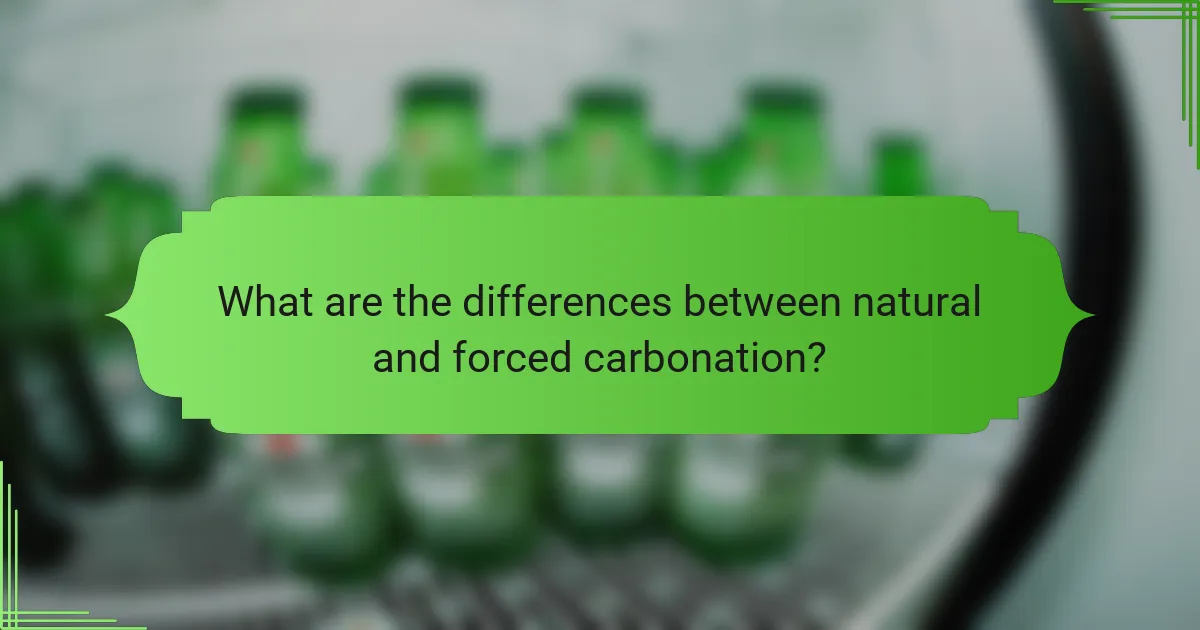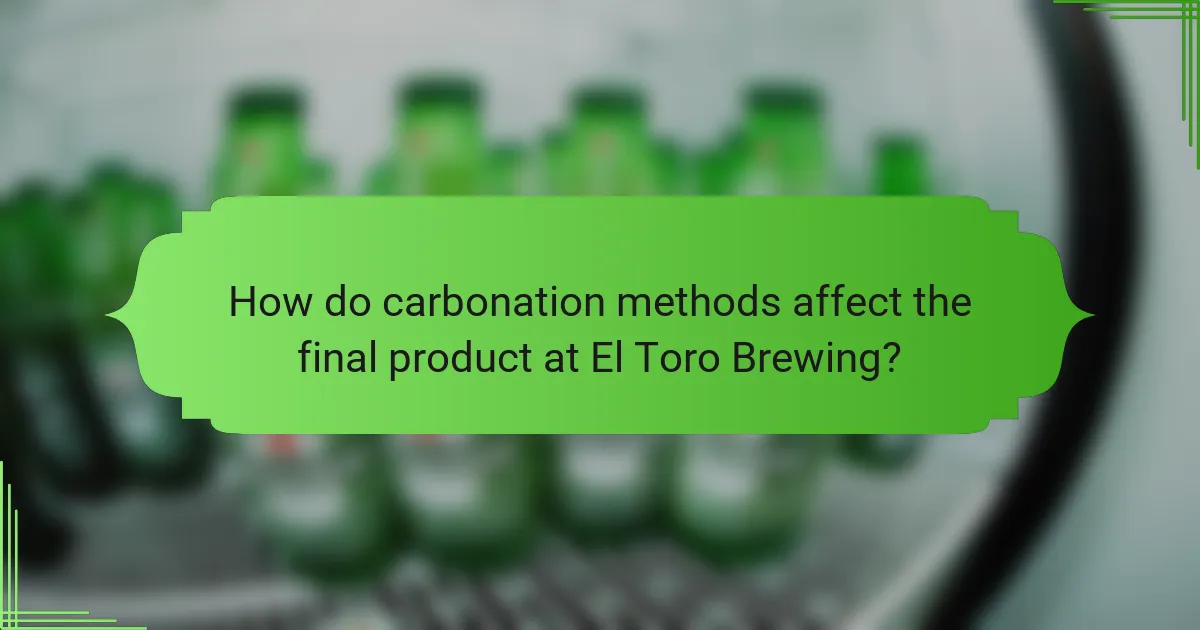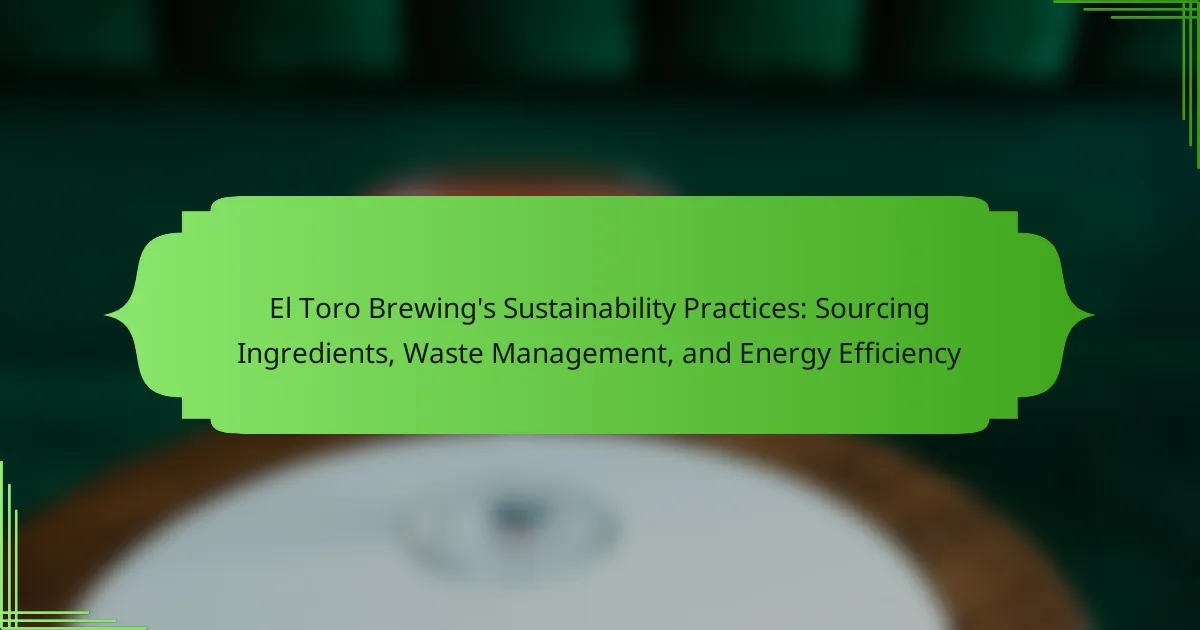El Toro Brewing employs two primary carbonation methods: natural carbonation and forced carbonation. Natural carbonation occurs through fermentation, where yeast produces carbon dioxide, enhancing the beer’s flavor profile and mouthfeel. In contrast, forced carbonation involves the direct injection of carbon dioxide under pressure, allowing for precise control over carbonation levels and a quicker process. Each method significantly influences the final beer characteristics, affecting flavor complexity, mouthfeel, aroma, and consumer preferences, which can impact marketability. This article explores these carbonation methods and their effects on the unique beers produced at El Toro Brewing.

What are the carbonation methods used at El Toro Brewing?
El Toro Brewing uses both natural carbonation and forced carbonation methods. Natural carbonation occurs through fermentation, where yeast produces carbon dioxide. This method enhances the beer’s flavor profile and mouthfeel. Forced carbonation involves adding carbon dioxide directly to the beer under pressure. This method allows for precise control over carbonation levels. Both methods contribute to the brewery’s unique beer characteristics.
How do natural carbonation methods work?
Natural carbonation methods work by utilizing fermentation to produce carbon dioxide. During fermentation, yeast consumes sugars and produces alcohol and CO2 as byproducts. This CO2 dissolves in the liquid under pressure, creating carbonation. The process typically occurs in a sealed environment to trap the gas. As fermentation progresses, the buildup of CO2 naturally carbonates the beverage. This method is often used in brewing beer and making sparkling wines. Natural carbonation can enhance the flavor profile and mouthfeel of the beverage. It is a traditional method that has been used for centuries in various cultures.
What ingredients are essential for natural carbonation?
The essential ingredients for natural carbonation are sugar and yeast. Sugar serves as the food source for yeast during fermentation. Yeast metabolizes the sugar, producing carbon dioxide as a byproduct. This carbon dioxide dissolves in the liquid, creating carbonation. Common sugars used include glucose, sucrose, or malt extract. The fermentation process typically takes one to two weeks to achieve desired carbonation levels. This method is widely used in home brewing and craft beer production. It is a traditional technique that enhances flavor and mouthfeel.
How does fermentation contribute to natural carbonation?
Fermentation contributes to natural carbonation by producing carbon dioxide (CO2) as a byproduct. During fermentation, yeast metabolizes sugars into alcohol and CO2. This CO2 is trapped within the liquid if the fermentation vessel is sealed. The buildup of CO2 creates pressure, leading to carbonation. In beer brewing, this process is essential for achieving the desired fizziness. Natural carbonation can enhance flavor and mouthfeel. It occurs without the need for additional gas injection. This method is often preferred for its organic and traditional characteristics.
What is forced carbonation and how is it applied?
Forced carbonation is a method of dissolving carbon dioxide gas into a liquid under pressure. This process is commonly used in the brewing industry to carbonate beverages quickly. During forced carbonation, the liquid is placed in a sealed container, and carbon dioxide is injected. The pressure causes the gas to dissolve into the liquid, creating carbonation.
This technique allows for precise control over carbonation levels. It can achieve desired carbonation much faster than natural methods, which rely on fermentation. Forced carbonation is often applied in commercial settings for efficiency. It can also be used in home brewing with the right equipment. The process ensures consistent results, making it a popular choice among brewers.
What equipment is necessary for forced carbonation?
The equipment necessary for forced carbonation includes a CO2 tank, a regulator, and a carbonation stone. A CO2 tank provides the carbon dioxide needed for carbonation. The regulator controls the pressure of the CO2 being released. A carbonation stone diffuses CO2 into the liquid, enhancing the carbonation process. Additionally, a keg or a pressure-rated fermenter is required to hold the beverage during carbonation. These components work together to achieve the desired carbonation level efficiently.
How does the CO2 injection process function in forced carbonation?
The CO2 injection process in forced carbonation involves the direct addition of carbon dioxide gas to a liquid. This method increases the carbonation level by dissolving CO2 under pressure. The liquid, often beer, is placed in a sealed vessel where CO2 is injected. The pressure forces the gas to dissolve into the liquid. This process typically occurs at temperatures between 32°F and 50°F to enhance solubility. The duration of CO2 exposure influences the carbonation level achieved. Studies show that higher pressure results in more CO2 absorption. This method allows for precise control over carbonation levels, ensuring consistency in the final product.

What are the differences between natural and forced carbonation?
Natural carbonation occurs when yeast ferments sugars, producing carbon dioxide. This process creates a more complex flavor profile. It typically takes longer than forced carbonation. The carbonation level is also less predictable.
Forced carbonation involves injecting carbon dioxide directly into the liquid. This method allows for precise control over carbonation levels. It is a faster process, often taking just a few hours. Forced carbonation can result in a cleaner taste compared to natural carbonation.
In summary, natural carbonation relies on fermentation, while forced carbonation uses CO2 injection. Each method impacts flavor and carbonation predictability differently.
How do the flavors differ between natural and forced carbonation?
Natural carbonation typically results in a smoother and more complex flavor profile. This method allows yeast to produce carbon dioxide during fermentation. The CO2 interacts with the beer, enhancing its natural flavors. In contrast, forced carbonation introduces CO2 directly into the beer under pressure. This can sometimes lead to a more pronounced, sharper carbonation. The flavor may be less integrated compared to natural carbonation. Natural carbonation can also contribute subtle esters and phenols from yeast activity. These compounds can add depth and character to the beer’s taste. Forced carbonation, while efficient, may not capture these nuances as effectively.
What role do yeast and fermentation play in flavor development?
Yeast and fermentation are crucial in flavor development during brewing. Yeast converts sugars into alcohol and carbon dioxide through fermentation. This process also produces various flavor compounds, such as esters and phenols. Esters contribute fruity and floral notes, while phenols can add spicy or smoky flavors. Different yeast strains generate distinct profiles, impacting the final taste of the beverage. Fermentation conditions, like temperature, further influence flavor complexity. For example, higher temperatures often increase ester production. Thus, the choice of yeast and fermentation methods significantly shapes the overall flavor experience in beer.
How does forced carbonation impact the mouthfeel of the beverage?
Forced carbonation enhances the mouthfeel of a beverage by introducing a sharper, more pronounced effervescence. This method creates smaller, more consistent bubbles compared to natural carbonation. The increased bubble density contributes to a creamier sensation on the palate. Additionally, forced carbonation can elevate the perceived carbonation level, making the drink feel livelier. Studies show that beverages with higher carbonation levels often have a more refreshing quality. This effect is particularly noticeable in styles like lagers and IPAs. Overall, forced carbonation significantly alters the sensory experience of the beverage.
What are the advantages and disadvantages of each carbonation method?
Natural carbonation involves fermenting sugars to produce carbon dioxide. The advantages include enhanced flavor complexity and a more natural process. It can also lead to a smoother mouthfeel. However, it requires more time and can be less predictable in carbonation levels.
Forced carbonation uses CO2 gas to achieve desired fizziness. Its advantages include speed and control over carbonation levels, allowing for consistent results. It is also easier to implement in a commercial setting. Disadvantages include the potential for off-flavors if not managed properly. Additionally, it may not provide the same depth of flavor as natural carbonation.
What are the benefits of using natural carbonation?
Natural carbonation enhances the flavor profile of beverages. It produces a smoother mouthfeel compared to forced carbonation. This method allows for the development of complex flavors during fermentation. Natural carbonation can also improve the aroma of the beverage. It contributes to a more authentic taste experience. Additionally, it often results in smaller, more delicate bubbles. These bubbles create a pleasant sensory experience. Natural carbonation can also reduce the need for added sugars. This is beneficial for health-conscious consumers.
What challenges might arise with forced carbonation?
Forced carbonation can lead to several challenges. One challenge is the potential for over-carbonation. This can result in excessive foam and loss of product during dispensing. Another challenge is the uneven distribution of carbonation. This may cause inconsistencies in taste and mouthfeel across different batches. Additionally, forced carbonation can introduce unwanted flavors. These flavors may stem from the CO2 source or the equipment used. Maintenance of carbonation equipment is also a concern. Regular cleaning is essential to prevent contamination and ensure quality. Lastly, forced carbonation can be less forgiving in terms of timing. This requires careful monitoring to achieve the desired level of carbonation.

How do carbonation methods affect the final product at El Toro Brewing?
Carbonation methods significantly influence the final product at El Toro Brewing. Natural carbonation typically results in a smoother mouthfeel and more complex flavor profiles. This occurs as yeast produces carbon dioxide during fermentation, enhancing the beer’s character. Forced carbonation, on the other hand, allows for precise control over carbonation levels. This method can lead to a crisper finish but may lack some of the depth found in naturally carbonated beers. Additionally, the choice of carbonation method affects the aroma and overall sensory experience. Research indicates that consumer preferences can vary based on these carbonation characteristics, impacting the marketability of the final product.
How does carbonation impact the shelf life of the beverages?
Carbonation extends the shelf life of beverages by inhibiting microbial growth. The presence of carbon dioxide creates an acidic environment. This acidity slows down the activity of spoilage organisms. Additionally, carbonation helps maintain the beverage’s freshness by preventing oxidation. Oxidation can lead to off-flavors and degradation. Studies indicate that carbonated drinks can last longer than non-carbonated counterparts. For example, carbonated soft drinks can remain stable for months when sealed. This stability is due to the pressure and environment created by carbonation.
What factors influence the stability of carbonation in different beers?
The stability of carbonation in different beers is influenced by several factors. These include the type of carbonation method used, such as natural or forced carbonation. Natural carbonation occurs through fermentation, producing CO2, while forced carbonation involves adding CO2 directly. The temperature during carbonation affects gas solubility; colder temperatures generally enhance stability.
Beer composition also plays a significant role. Higher alcohol content and residual sugars can lead to increased carbonation stability. Additionally, the presence of proteins and polyphenols in the beer can impact foam formation and gas retention.
Packaging methods further influence carbonation stability. Bottling and canning methods can create different pressure environments, affecting how long carbonation lasts. Lastly, storage conditions, such as light exposure and temperature fluctuations, can degrade carbonation over time.
How does carbonation level affect consumer perception of quality?
Carbonation level significantly impacts consumer perception of quality. Higher carbonation levels are often associated with freshness and a more enjoyable sensory experience. Studies indicate that consumers prefer beverages with optimal carbonation as it enhances aroma and flavor perception. For example, a study published in the Journal of Sensory Studies found that higher carbonation levels improved overall liking scores among participants. Additionally, excessive carbonation can lead to negative perceptions, such as overwhelming fizziness or discomfort while drinking. Therefore, achieving the right carbonation balance is crucial for positive consumer feedback and perceived quality.
What best practices should be followed in carbonation processes?
Maintain consistent temperature during carbonation. This ensures even gas solubility. Use high-quality CO2 to prevent off-flavors. Monitor pressure levels to achieve desired carbonation levels. Implement proper sanitation practices to avoid contamination. Allow adequate time for carbonation to develop fully. Regularly calibrate equipment for accurate measurements. Conduct taste tests to ensure quality control.
How can brewers optimize carbonation for desired flavor profiles?
Brewers can optimize carbonation for desired flavor profiles by adjusting the levels of dissolved CO2. This can be achieved through careful control of temperature and pressure during the carbonation process. Higher temperatures can increase carbonation efficiency, while lower temperatures can preserve delicate flavors.
Additionally, brewers can experiment with different carbonation techniques, such as natural carbonation through fermentation or forced carbonation using CO2 tanks. Natural carbonation can enhance flavor complexity, while forced carbonation allows for precise control over carbonation levels.
Research indicates that the optimal carbonation level can vary significantly depending on the style of beer. For example, a study published in the Journal of the American Society of Brewing Chemists found that higher carbonation levels can enhance the perception of hop aroma in IPAs.
By understanding the relationship between carbonation and flavor perception, brewers can tailor their carbonation methods to achieve the desired taste profile in their beers.
What common troubleshooting tips are available for carbonation issues?
Ensure the CO2 tank is properly connected and filled to avoid low carbonation. Check for leaks in the system, as they can lead to pressure loss. Adjust the pressure regulator to the recommended settings for your specific beverage type. Allow sufficient time for carbonation to occur, as it can take several days for natural methods. Monitor temperature, as colder temperatures help retain CO2 better. If using forced carbonation, shake the keg gently to expedite the process. Clean the lines and connectors regularly to prevent buildup that can affect carbonation levels. Lastly, taste the beverage to assess carbonation levels, adjusting as necessary.
El Toro Brewing is the primary entity discussed in the article, focusing on its carbonation methods: natural and forced carbonation. The article outlines how natural carbonation utilizes fermentation to produce carbon dioxide, enhancing flavor and mouthfeel, while forced carbonation involves injecting CO2 for precise control and quicker results. Key points include the essential ingredients for natural carbonation, the equipment needed for forced carbonation, and the differences in flavor profiles and mouthfeel between the two methods. Additionally, the article addresses the impact of carbonation on shelf life, consumer perception of quality, and best practices for optimizing carbonation processes.


